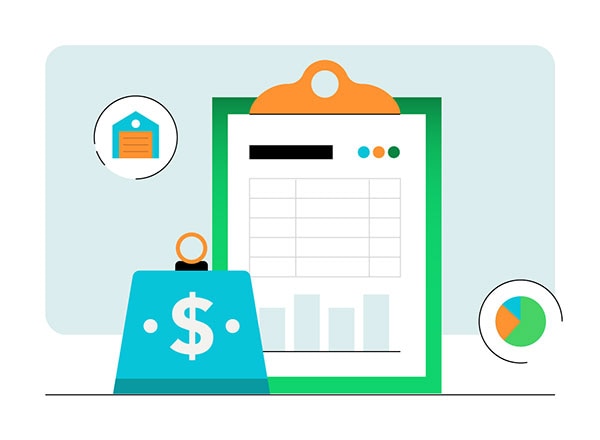Small business owners are expected to do it all. That includes accounting, which is a complicated topic in its own right. But as a small business owner, understanding basic accounting terms can help. A common accounting term you may come across is “current assets.” Let’s explore what that term means, some examples, and how to calculate them.

Understanding your small business’s current assets
What are current assets?
Current assets are the business assets that you expect to convert to cash within a—typically, one-year—operating cycle. Your current assets can be existing cash, the inventory you plan to sell, supplies you need for a service, your investments, or other cash equivalents.
Typically, businesses calculate their operating cycles yearly. However, some businesses will have extended operating cycles that exceed a year. Either way, your current assets will still be determined by what you can turn into cash during that cycle.
Why are current assets important?
One of the main reasons current assets are important for your business is because they represent how much money you have to fund your day-to-day operation and fulfill your current liabilities — i.e., the money you owe to third parties that you need to pay within a year. These liabilities might include the amounts you owe to suppliers (accounts payable), credit card balances, income tax liabilities, and short-term loan payments like a line of credit.
When your current assets exceed your current liabilities, it’s usually a good sign that your business is financially stable. This stability can give your investors, lenders, and stakeholders confidence in your business because it shows you responsibly handle short-term debts and potential unexpected costs without scrambling for additional resources.
What are noncurrent assets?
Noncurrent assets are any long-term assets that won’t develop into cash within a year or the business’s operating cycle. Noncurrent assets might include patents, equipment, real estate, and cash surrendered from canceling insurance (cash surrender value). Noncurrent assets are “illiquid,” meaning you cannot turn them into cash easily.
7 examples of current assets
1. Cash
Cash is your most liquid asset. As the term implies, cash assets include any cash on hand. Cash assets include
- Paper bills and coins.
- Checks.
- Money orders.
2. Cash equivalents
Typically, cash equivalents are mostly liquid. Business owners may store cash equivalents in a bank or other interest-earning financial institution, such as a stock fund. Cash equivalents can include
- U.S. Treasury bills.
- Bank accounts for your business.
- Stock or money market funds.
3. Inventory
Inventory assets are any assets you intend to sell to your customers and the materials you need to create those goods. Inventory may include
- Finished goods ready for sale.
- Goods in production.
- Raw materials needed to create goods.
But determining the cost of inventory is more than the item’s sticker price. You also have to calculate how much it costs your business to have that item in stock. Costs may include shipping, supplier charges, storage costs, and other associated costs.
4. Accounts receivable
Your accounts receivables include any money customers owe your business. Accounts receivable include purchases made on credit and projects you’ve completed that a customer has yet to pay for in full. The most important distinction about your accounts receivable is that they must be paid within your business’s operating cycle to qualify as current assets.
5. Prepaid expenses
Prepaid expenses include any payments made to the business from other companies for future goods or services. Prepaid expenses count as current assets as long as the benefit or use of the prepaid item has not expired. They must also be within your business’s operating cycle. Prepaid expenses include
- Leased office equipment.
- Insurance payments.
- Contractor payments.
6. Temporary investments
Temporary investments are any company investments that you may liquidate within a business’s operating cycle. These investments are also called “marketable securities.” The most common examples are government bonds or stocks. Because these assets are tied into the stock market, their value can fluctuate. When calculating your temporary investments, record their value as their current market value.
7. Other liquid assets
The last type of asset is any current asset your business owns that you can liquidate within the business’s operating cycle. These assets can include tax-deductible expenses or pre-tax income gains.
Calculating current assets
Calculating your current assets is straightforward. You simply need to add up all your different assets. Let’s break it down step by step to make sure everything is clear.
Step 1: Identify cash and cash equivalents
Start by identifying your cash and cash equivalents. These are your most liquid assets — i.e., things you can quickly convert into cash. Obviously, this includes cash, but it may also include money in your business bank account or brokerage account.
Example:
- Cash on hand: $5,000
- Bank balances: $10,000
- Short-term investments: $2,000
Total Cash and Cash Equivalents: $17,000
Step 2: Account for accounts receivable
Next, add up your accounts receivable, which is the amount of money customers owe to your business for goods and services they’ve received but haven’t paid for yet. For example, if you run a subscription-based site, the amount owed would fall under this category.
Example:
- Accounts receivable: $8,000
Step 3: Include inventory
If your business deals with inventory, be sure to include the total value of your stock. This includes raw materials, products in progress, and finished goods ready to be sold.
Example:
- Inventory: $15,000
Step 4: Add prepaid expenses
Don't forget to include your prepaid expenses — you've already made for goods or services you'll receive in the future, such as leased equipment and insurance premiums.
Example:
- Prepaid insurance: $1,000
- leased equipment: $2,000
Total Prepaid Expenses: $3,000
Step 5: Sum up all current assets
Finally, add up all the total from the previous steps to get your total current assets.
Calculation:
- Cash and Cash Equivalents: $17,000
- Accounts Receivable: $8,000
- Inventory: $15,000
- Prepaid Expenses: $3,000
Total Current Assets: $43,000
Current assets formulas and balance sheets
Typically, businesses will list their current assets on a balance sheet , in descending order of liquidity. Items that have a higher chance of converting to cash will rank higher on the balance sheet. Items that may take longer or are less likely to turn into cash will be at the bottom.
Once you have your current assets listed out, you can add them together to determine the total amount of current assets. There are also other financial formulas you can use to determine the health of your business and assets. Here are three other common financial formulas that use current assets.
1. Current ratio
Your current ratio evaluates your company’s ability to meet any short- and long-term obligations. The ratio, also known as “working capital,” compares your total current assets to your current liabilities. Current liabilities are any financial obligations a company has that will be due within an operating cycle.
A current ratio lower than the industry average suggests the company is at a higher risk of default. They will be unable to balance what they owe with what they own. Meanwhile, companies whose current ratio is too high above the industry standard suggests they aren’t using their assets efficiently. Companies should aim to have a current ratio that is average or slightly above average. The current ratio formula includes
Current assets / current liabilities = current ratio
2. Quick ratio
Use your quick ratio to determine your company’s short-term solvency. Calculate this by determining which of your current assets are the most liquid. Then use that to meet your short-term obligations. Typically, your quick ratio does not include assets such as inventory. The quick ratio formula includes:
(Cash + cash equivalents + temporary investments + accounts receivable) / current liabilities = quick ratio
3. Cash ratio
Your cash ratio measures your business’s total cash and cash equivalents, in relation to your current short-term liabilities. This ratio determines a company’s ability to meet its short-term debt obligations using its most liquid assets. The cash ratio formula includes
(Cash + cash equivalents) / current liabilities = cash ratio
Increasing your current assets
If you find yourself struggling to meet customer demand, fulfill your orders, or pay for expenses, follow this step-by-step guide to help you increase your current assets.
Step 1: Sell assets
First, do some spring cleaning and identify any unnecessary assets your business owns that you could potentially sell. For example, if you have machinery that your company doesn’t use anymore or excess stock taking up space, selling these items can quickly give you the cash needed to cover immediate expenses without taking on additional debt.
Step 2: Optimize accounts receivable
Outstanding payments can tie up your cash and hurt your liquidity, so focus on how you can get paid faster. A couple of ways you can do this is by offering a small discount for customers who pay their invoices early or switching from 30-day terms to 15-day terms. Also, consider using invoice software to send automatic reminders to your customers and get real-time tracking on your overdue payments.
Step 3: Manage inventory efficiently
If you have inventory collecting dust, these unsold products are just tying up cash that you could be putting to better use. Using inventory management software, identify slow-moving or outdated stock and find ways to liquidate it — e.g., discounts, bundle deals, flash sales, etc. And moving forward, you might consider adopting the Just-in-time (JIT) inventory method, which focuses only on ordering products when you need them so you can reduce the risk of overstocking.
Step 4: Increase short-term investments
Another way to boost your current assets is by exploring short-term, liquid investments, including certificates of deposit (CDs) with short maturity periods, Treasury bills, or high-yield savings accounts. These types of investments provide a way to earn interest or returns on idle cash while still having access to your funds when you need it.
Step 5: Control prepaid expenses
Expenses like rent, utilities, and insurance are necessary, but there are ways you might be able to control the costs. For example, Instead of prepaying a full year of insurance, see if you can opt for quarterly or monthly payments so you can keep more cash on hand. Also, if you have a landlord, find out they’re open to negotiating more flexible payment terms.
Step 6: Enhance sales and revenue
The more sales you generate, the more current assets your business will have. Focus on specific strategies to boost revenue, such as introducing seasonal promotions or discounts to drive sales during slow periods. You could also try to diversify your revenue streams. For instance, if you run a retail business, offering a subscription box with monthly deliveries could provide consistent revenue.
Step 7: Reduce short-term liabilities
If possible, reduce your short-term liabilities. For example, you can try to negotiate better payment terms with your suppliers, like moving from 30 days to 60 days. This way, you give yourself more time to collect payments from your customers or generate revenue before needing to pay off your debts. Additionally, if you’re paying If you’re paying off a high-interest credit line, consider refinancing it into a lower-interest, long-term loan. This move will lower your monthly payments and reduce the strain on your cash flow so you can use more funds for immediate business needs.
Growing your accounting knowledge
Accounting is a tough subject, but knowing the basic terms can help you build a solid foundation for your business. Many small business owners choose to take this challenge head-on. But accountants, bookkeepers, and financial tools can help you manage your business finances even more. Whether you run your books yourself or get help from financial professionals, having a financially savvy foundation is always good for business.









